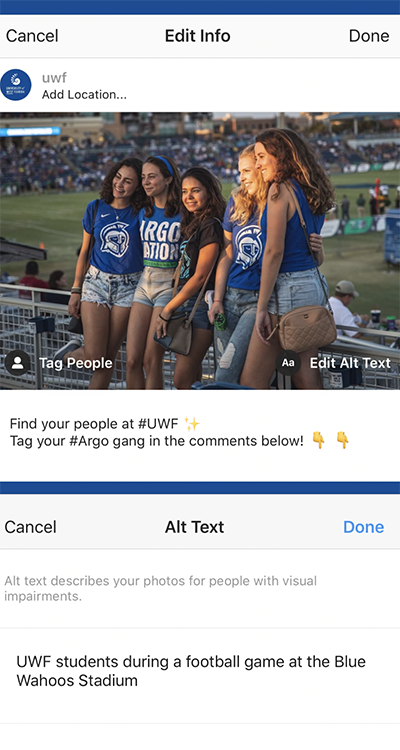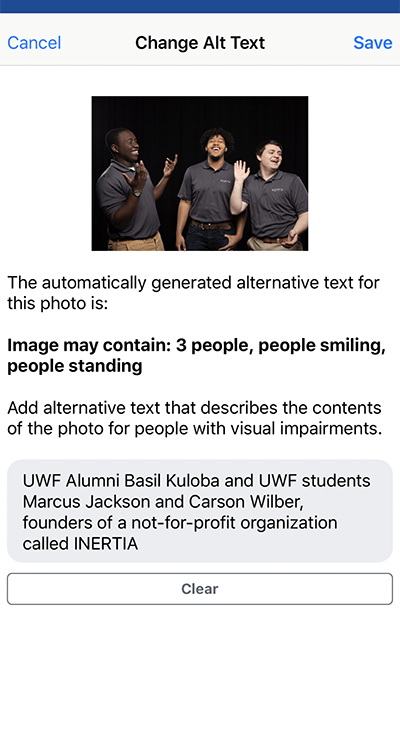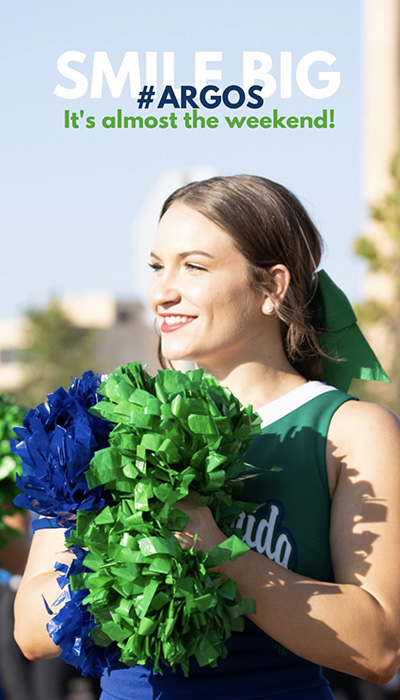Social Media Accessibility Guidelines
As online communities have become an important means of social interaction and community participation, ensuring their universal accessibility is essential for social inclusion at the University of West Florida. Social media accounts and content associated with the University should be designed, developed and edited making a best effort to uphold accessibility standards, in order to allow for all users to have equal access to information and functionality.
Individuals with disabilities use technologies such as screen readers, captioning software and other tools that enable them to hear or read the content on their device. To ensure that access to content is seamless for users with disabilities, social media content developed and shared by University accounts must comply with Section 508 of the Rehabilitation Act.
Social media is not always completely accessible due to the limited technical control over social media platforms and posted content. Below are the social media accessibility best practices:
- Most major social media platforms have accessibility help pages that provide directions on how to make content posted as accessible as possible.
- Photos posted on social media outlets should contain alternative text descriptions.
- Facebook, X and Instagram all have the ability to edit and customize alt text captions retroactively.
- Facebook and Instagram generate an automatic general alt text, but allow accounts to edit the alt text on their website or app after posting.
- When editing an automatic general alt text, provide descriptive captions for images. Make sure you are describing the content of the image. Mention colors, people, scenes, etc.

Instagram Alt Text Example

Facebook Alt Text Example

X Alt Text Example
- Provide captions and an audio transcript with every video. Export an SRT caption file and a “burned in” captioned version of the video for each project. SRT files should be named VIDEONAME.en_US.srt.
- Facebook allows users to automatically generate captions and edit them, write them yourself or the option to upload a SubRip (.srt) file. Instagram videos must have captions burned in or encoded in advance. Hosting your videos through YouTube allows for captions and links transcript files.
- Videos posted on YouTube must have an audio description created via YouDescribe within one week after upload. YouTube also allows you to upload a text file, or transcribe your video in real time.
- Resources: Premiere Pro Captioning Tutorial
- Please see our Confluence page for more information on Accessible Recorded Audio and Video.
- Graphics posted should rarely contain text.
- Posters, invitations, postcards and other media that are designed for print may not be used on social media. Print materials are not designed for web applications, as they contain embedded text and print color modes, and their linear structure often does not correspond well to social media or websites.
- Avoid placing text on a graphic or photo. Instead, text should always be incorporated into the caption. Alt text is helpful for a subset of users with low vision, but some users magnify content instead of using screen readers. Magnified images containing text become blurry and unreadable.
- There are some instances when text is needed on a graphic. In this situation, the text should be minimal as to not crowd the graphic and the text must be present in the associated caption. Font on the graphics needs to be legible and a color that contrasts with the photo.
- When using call-to-action words on a graphic, avoid being generic like “click here.” Be descriptive with words like “tap here for more information” or “apply here.”
- Several examples include: Instagram stories, holiday graphics, weather alerts, etc.



- It is always best to use the full department name in your social media post captions. When only the acronym is used for the department name, it can be confusing to users who do not know what the acronym stands for.
- When using hashtags, capitalize the first letter of each word within the hashtag. Ex. #GoArgos or #ArgoNation
- Limit the use of emojis and emoticons in social media posts. Screen readers will use descriptions for each emoji and each character within emoticons which can become time consuming and affect user experience.
- Animated GIFs have limited accessibility support on social media platforms. The use of GIFs should be limited and not be the main content in a post.
- Avoid using alternative characters from external sites to make captioning copy appear in different styles, weights and typefaces. Not all assistive devices and programs can identify or translate alternative character sets and will skip over them instead, resulting in low engagement and searchability.


